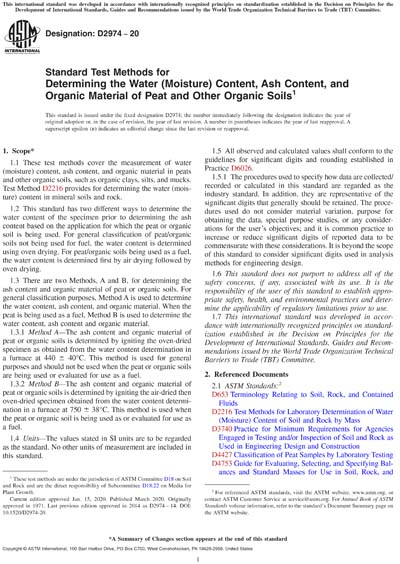Historical
ASTM D2974-20
Standard Test Methods for Determining the Water (Moisture) Content, Ash Content, and Organic Material of Peat and Other Organic Soils
1.1 These test methods cover the measurement of water (moisture) content, ash content, and organic material in peats and other organic soils, such as organic clays, silts, and mucks. Test Method D2216 provides for determining the water (moisture) content in mineral soils and rock.
1.2 This standard has two different ways to determine the water content of the specimen prior to determining the ash content based on the application for which the peat or organic soil is being used. For general classification of peat/organic soils not being used for fuel, the water content is determined using oven drying. For peat/organic soils being used as a fuel, the water content is determined first by air drying followed by oven drying.
1.3 There are two Methods, A and B, for determining the ash content and organic material of peat or organic soils. For general classification purposes, Method A is used to determine the water content, ash content, and organic material. When the peat is being used as a fuel, Method B is used to determine the water content, ash content and organic material.
1.3.1 Method A—The ash content and organic material of peat or organic soils is determined by igniting the oven-dried specimen as obtained from the water content determination in a furnace at 440 ± 40°C. This method is used for general purposes and should not be used when the peat or organic soils are being used or evaluated for use as a fuel.
1.3.2 Method B—The ash content and organic material of peat or organic soils is determined by igniting the air-dried then oven-dried specimen obtained from the water content determination in a furnace at 750 ± 38°C. This method is used when the peat or organic soil is being used as or evaluated for use as a fuel.
1.4 Units—The values stated in SI units are to be regarded as the standard. No other units of measurement are included in this standard.
1.5 All observed and calculated values shall conform to the guidelines for significant digits and rounding established in Practice D6026.
1.5.1 The procedures used to specify how data are collected/recorded or calculated in this standard are regarded as the industry standard. In addition, they are representative of the significant digits that generally should be retained. The procedures used do not consider material variation, purpose for obtaining the data, special purpose studies, or any considerations for the user’s objectives; and it is common practice to increase or reduce significant digits of reported data to be commensurate with these considerations. It is beyond the scope of this standard to consider significant digits used in analysis methods for engineering design.
1.6 This standard does not purport to address all of the safety concerns, if any, associated with its use. It is the responsibility of the user of this standard to establish appropriate safety, health, and environmental practices and determine the applicability of regulatory limitations prior to use.
1.7 This international standard was developed in accordance with internationally recognized principles on standardization established in the Decision on Principles for the Development of International Standards, Guides and Recommendations issued by the World Trade Organization Technical Barriers to Trade (TBT) Committee.
Content Provider
ASTM International [astm]






